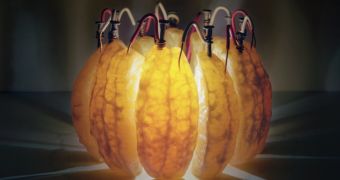When it comes to thinking about examples of alternative and environmentally-friendly energy sources, most people have a rather mainstream process of thought: it has to be either solar, wind, wave or geothermal power.
Still, Caleb Charland managed to prove that a simple orange can be made to generate electrical current, provided, of course, that one knows exactly how to encourage it to do so.
Interestingly enough, Caleb Charland is not a scientist, but a professional photographer, meaning that his commitment to turning fruits into alternative batteries is all the more noteworthy.
In the past, Caleb Charland obtained similar results with the help of apples and glasses of vinegar, but this was the first time when he used just one fruit.
"Recently one Sunday I spent the day at the kitchen table playing with oranges, copper wires and galvanized nails. My hope was that I could make this ongoing project work with a single piece of fruit."
"I tried cutting it into slices and wedges but that ever present voice in my head reminded me the simpler is better," Caleb Charland's blog reads.
Caleb Charland's orange-powered battery comes as a result of galvanized nails being inserted into the fruit's pulp and made to react with the citric acid.
Truth be told, the electricity generated in this manner only succeeded in powering an embedded LED bulb, and even so, the light was anything but bright.
Thus, the artist only succeeded in coming up with the photo of a fully glowing orange after a 14-hour-long exposure.
As the artist puts it, "It only seemed logical to use the orange’s natural wedges as the cells for the battery."
"The wedges are held up-right with an armature of small wooden skewers. The LED is nestled within the bounds of the orange wedges. I’m still amazed this worked…though it did require 14 hours of exposure."
It is Caleb Charland's hope that art projects such as this one will help raise awareness with respect to the need to push for energy efficiency and sustainability.

 14 DAY TRIAL //
14 DAY TRIAL //